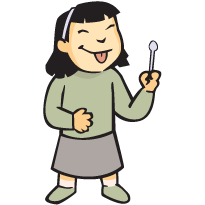Boston Children's Museum
308 Congress Street, Boston, MA 02210
617-426-6500
© Boston Children’s Museum 2025
Website Design by JackrabbitThere are many activities in this curriculum that involve cooking—and that means tasting too. Getting kids in tune with their taste buds can help them to use their tongues not just as a way of enjoying what they make, but also to use their sense of taste as another tool for exploring the world around them.

Ask your students if they can name the flavors that their tongue can taste. When they come up with sweet, salty, sour and bitter, take a poll—whose favorite taste is salty? Whose is sour? Record the results.
Make a map of your tongue!
After each child has made their first map, stop your students and bring them together to share their observations with each other. Have them post their maps up on a wall and compare, or you can draw a big tongue on a chalkboard or piece of chart paper and have each child mark on that tongue where they tasted sweet, salty, sour and bitter. This second option will give you one big classroom “tongue map”. Do they notice any patterns, or is each tongue different? Refer back to their earlier survey—does anyone want to change their vote for their favorite flavor?
Have your students return to their tables in pairs to try a new experiment. This time, one child will be the “taster”, and one will be the “tester”. The taster should sit in a chair with their eyes closed and their tongue sticking out. The tester should pick a flavor but not tell the taster what they’re choosing, dip a cotton swab in that flavor and rub it on the taster’s tongue. Can the taster guess the flavor? Next, have the tasters close their eyes, pinch their noses shut and repeat the test, again with a random flavor. Can they guess now? What if they release their hold on their nose—is it easier to guess? Have them switch roles so each child has a chance to try.